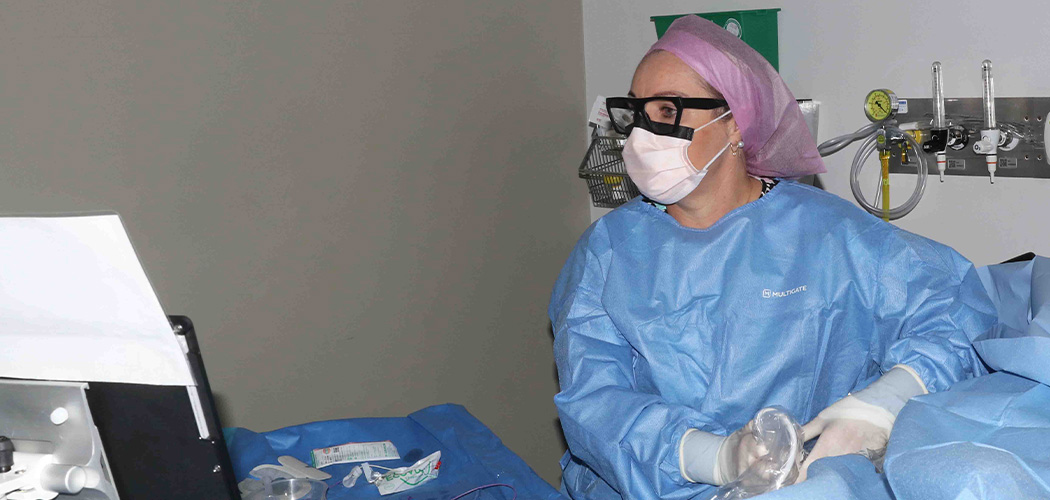A unique Queensland first, nurse-led vascular access team is reducing catheter-associated complications and improving the patient experience.
Sunshine Coast Hospital and Health Service’s vascular access surveillance and education (VASE) service sees specially trained nurses insert peripherally inserted central catheters (PICCs), guided by ultrasound.
“Years ago, this was traditionally a procedure that was done by medical officers, now nurses do it. This model is very cost effective, mobile, more efficient, means the patient doesn’t have to be exposed to radiation, and can be used immediately,” said Leanne Ruegg, VASE Clinical Nurse Consultant.
The service started in 2009 with bedside insertion (confirmed by chest x-ray), and expanded to use the ECG method in February 2016, negating the need for a chest x-ray. PICCs are confirmed by using a sensor that tracks a magnetic tip relative to the heart and placed at the Cavo-atrial junction.
“We were the first nurse-led team in Queensland to utilise and clear using this technology. The beauty of it is we get a referral, we go to the bedside, and we insert it in the patient’s room,” said Ms Ruegg.
“For instance, you might have a patient who is not recovering well from abdominal surgery, and they’ve been prescribed TPN, and they need a central catheter. Beforehand we would go and insert the catheter, then they would need to wait for a chest x-ray and then a medical officer to review the chest x-ray. Whereas with this model of care we go in and 98% of the time we can clear it at the bedside. Using the model, you can now get a PICC line inserted at 3pm, cleared by 4pm and TPN can be up within an hour.”
The insertion of a PICC means patient care can be continued in a non-inpatient setting such as Hospital in the Home and outpatient clinics, which helps improve bed utilisation and patient flow.
“When we get a referral for a PICC, we do a patient assessment to ensure that they’re getting the right device at the right time. Or we might recommend another form of vascular access device that might be more appropriate for that patient, so we do a full assessment, it’s all about the patient.”
The nurse-led team does surveillance of invasive devices and yearly reviews of all central venous catheters. “We are the clinical expert when it comes to the care and maintenance of these devices as well as the dressings, and the bungs that we use etc. We act as a consultation service for the wards if there are any issues like excessive bleeding or concerns if lumens block,” said Ms Ruegg.
A retrospective analysis of 661 PICC insertions study, found the VASE nurse-led service demonstrated minimal infection and thrombus complications. “We reported lower rates of catheter-related bloodstream infections and catheter-related deep venous thrombosis than other previously published studies and I’m really proud of that,” said Ms Ruegg.
The low complication rate has been attributed to the highly experienced nurses in the team, the use of a standardised insertion bundle, and the tip navigation/confirmation system.
“The results are reassuring and a clear indication of the benefits of nurses working to top of scope,” said Ms Ruegg.
The concept of a nurse-led service clearing PICC lines requires a cultural change, she said. “Stakeholder consultation and getting the backing from the radiology team was vital for us to get it off the ground and obviously it takes a big load off them not having to do elective PICC insertions. The support from clinical and senior medical staff played a significant role in our success.”
Despite some advanced teams in Australia, the vascular access specialty is still an emerging nurse specialty compared with Europe with extensive nurse-led models beyond PICC line insertion. Ms Ruegg is travelling to the UK in June to visit to two NHS Trusts with successful models of care for brachial port insertion being used in women with breast cancer.
“I’m always exploring and forever trying to improve how we do things, because research, evidence and practice evolves all the time.”
For more information visit Clinical Excellence Queensland Improvement Exchange https://clinicalexcellence.qld.gov.au/improvement-exchange
Reference
Ruegg et al. Peripherally inserted central catheter-associated complications: a retrospective review of a nurse-led peripherally inserted central catheter-insertion service. Vascular Access 2020; 6(1):16-19. DOI https://doi.org/10.33235/va.6.1.16-19









